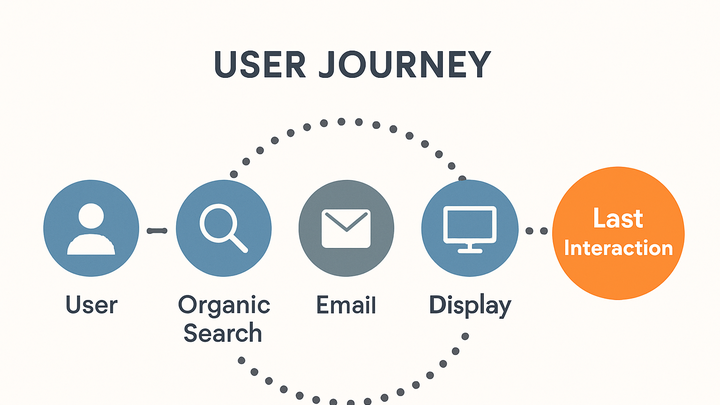Published on 2025-06-22T08:10:57Z
What is Last Interaction? Understanding Last Interaction Attribution in Analytics
Last Interaction is an attribution model used in digital analytics to assign conversion credit to the final touchpoint a user interacts with before completing a goal. This model simplifies reporting by focusing on the last user action, whether it’s a click on an ad, a form submission, or another defined conversion event. It is widely used in platforms like Google Analytics 4 (GA4) and PlainSignal, providing clear insights into which channels are most directly driving conversions. By highlighting the final user interaction, marketers can optimize campaigns, allocate budgets more effectively, and understand the impact of top-of-the-funnel versus bottom-of-the-funnel activities. However, this model may undervalue earlier touchpoints, which is why it’s often used alongside multi-touch attribution models for a more holistic view.
Last interaction
An attribution model that credits the final touchpoint before conversion for clear ROI analysis.
Definition and Context
This section defines the Last Interaction attribution model, explaining how it credits the final touchpoint before conversion and its role in digital analytics.
-
Attribution model definition
Last Interaction is a single-touch attribution model that assigns 100% of conversion credit to the user’s final interaction before a conversion event.
Implementation Examples
How to track Last Interaction events in popular analytics tools.
-
PlainSignal tracking
Integrate Last Interaction tracking in PlainSignal by adding the cookieless snippet to your site’s HTML:
<link rel="preconnect" href="//eu.plainsignal.com/" crossorigin /> <script defer data-do="yourwebsitedomain.com" data-id="0GQV1xmtzQQ" data-api="//eu.plainsignal.com" src="//cdn.plainsignal.com/plainsignal-min.js"></script>PlainSignal then automatically attributes conversions to the last pageview or event captured by this script.
-
Script placement
Place both the preconnect link and script tag in the <head> section for optimal loading and attribution accuracy.
-
Cookie-free design
PlainSignal uses cookieless tracking, simplifying compliance and ensuring accurate last interaction capture without user consent dialogs.
-
-
GA4 tracking
To implement Last Interaction attribution in GA4, install the Global Site Tag and review the default last-click attribution model:
<script async src="https://www.googletagmanager.com/gtag/js?id=G-XXXXXXX"></script> <script> window.dataLayer = window.dataLayer || []; function gtag(){dataLayer.push(arguments);} gtag('js', new Date()); gtag('config', 'G-XXXXXXX'); </script>GA4 uses a last-click model by default for most conversion reports, attributing the conversion to the final tracked interaction.
-
Install global site tag
Add the gtag.js snippet with your GA4 measurement ID to every page to enable event tracking.
-
View last-click reports
In GA4’s Attribution settings, select the last-click model to see how your channels perform based on the final interaction before a conversion.
-
Advantages of Last Interaction Model
The Last Interaction model offers simplicity and actionable insights by focusing on the final touchpoint before conversion.
-
Simplicity
Easy to understand and implement with no complex weighting; perfect for quick reporting.
-
Clear roi focus
Directly ties conversion credit to the channel or action that sealed the deal, aiding budget allocation.
-
Quick setup
Supported out-of-the-box by most analytics platforms like GA4 and PlainSignal, requiring minimal configuration.
Limitations and Best Practices
While straightforward, the Last Interaction model has limitations and is best used alongside other attribution approaches.
-
Bias toward last click
Ignores the influence of earlier touchpoints, which can undervalue awareness and consideration stages in the customer journey.
-
Recommended practices
Combine Last Interaction with multi-touch models and regularly review attribution settings to get a balanced view of your marketing performance.
-
Adopt multi-touch attribution
Use models like linear or time-decay attribution to distribute credit across all touchpoints for a holistic perspective.
-
Regular attribution audits
Periodically compare Last Interaction results with other models and funnel analyses to detect any systematic biases.
-
